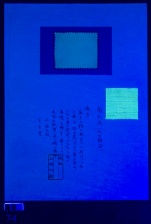Difference between revisions of "Nanten no ki (Nandina) - top(74 T)"
Jump to navigation
Jump to search
(username removed) |
m (MDerrick moved page Nanten no ki - top(74 T) to Nanten no ki (Nandina) - top(74 T) without leaving a redirect) |
||
| (One intermediate revision by one other user not shown) | |||
| Line 5: | Line 5: | ||
| 74 | | 74 | ||
|- | |- | ||
| − | ! scope="row"| | + | ! scope="row"|Uemura number / title |
| − | | | + | | ; "Haze-some 25" |
|- | |- | ||
! scope="row"|Folder location | ! scope="row"|Folder location | ||
| Line 44: | Line 44: | ||
| ash water | | ash water | ||
|- | |- | ||
| − | ! scope="row"| | + | ! scope="row"|Uemura's notes |
| The sample was soaked in a boiling bath containing dye extract and ash water. If a fabric would be soaked into a bath of the dye extract first, followed by a separate bath of ash water, the resultant dyed color would be more red. However, the red tone would decrease as the fabric dries. | | The sample was soaked in a boiling bath containing dye extract and ash water. If a fabric would be soaked into a bath of the dye extract first, followed by a separate bath of ash water, the resultant dyed color would be more red. However, the red tone would decrease as the fabric dries. | ||
|- | |- | ||
| − | ! scope="row"| | + | ! scope="row"|Uemura's date |
| Kyoto | | Kyoto | ||
|} | |} | ||
| − | [[Category: | + | [[Category:Uemura dye archive]] |
Latest revision as of 16:48, 23 June 2020
| Museum number | 74 |
|---|---|
| Uemura number / title | ; "Haze-some 25" |
| Folder location | 1st shelf |
| Sample location | top(74 T) |
| Fiber type | silk |
| Color | dull light beige |
| Dyestuff (Japanese common name) | 南天の樹 : Nanten no ki |
| Dye (English common name) | Nandina |
| Dyestuff (botanical name) | Nandina domestica Thunb. |
| Plant part | branch /withered, dried |
| Dyestuff extraction | boiled in water |
| Auxiliary agent in dye bath | - |
| Mordant | - |
| Other auxiliary agent | ash water |
| Uemura's notes | The sample was soaked in a boiling bath containing dye extract and ash water. If a fabric would be soaked into a bath of the dye extract first, followed by a separate bath of ash water, the resultant dyed color would be more red. However, the red tone would decrease as the fabric dries. |
| Uemura's date | Kyoto |

